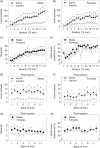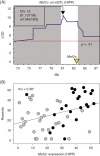Systems genetics of sensation seeking
- PMID: 30221471
- PMCID: PMC6399063
- DOI: 10.1111/gbb.12519
Systems genetics of sensation seeking
Abstract
Sensation seeking is a multifaceted, heritable trait which predicts the development of substance use and abuse in humans; similar phenomena have been observed in rodents. Genetic correlations among sensation seeking and substance use indicate shared biological mechanisms, but the genes and networks underlying these relationships remain elusive. Here, we used a systems genetics approach in the BXD recombinant inbred mouse panel to identify shared genetic mechanisms underlying substance use and preference for sensory stimuli, an intermediate phenotype of sensation seeking. Using the operant sensation seeking (OSS) paradigm, we quantified preference for sensory stimuli in 120 male and 127 female mice from 62 BXD strains and the C57BL/6J and DBA/2J founder strains. We used relative preference for the active and inactive levers to dissociate preference for sensory stimuli from locomotion and exploration phenotypes. We identified genomic regions on chromosome 4 (155.236-155.742 Mb) and chromosome 13 (72.969-89.423 Mb) associated with distinct behavioral components of OSS. Using publicly available behavioral data and mRNA expression data from brain regions involved in reward processing, we identified (a) genes within these behavioral QTL exhibiting genome-wide significant cis-eQTL and (b) genetic correlations among OSS phenotypes, ethanol phenotypes and mRNA expression. From these analyses, we nominated positional candidates for behavioral QTL associated with distinct OSS phenotypes including Gnb1 and Mef2c. Genetic covariation of Gnb1 expression, preference for sensory stimuli and multiple ethanol phenotypes suggest that heritable variation in Gnb1 expression in reward circuitry partially underlies the widely reported relationship between sensation seeking and substance use.
Keywords: BXD; Gnb1; Mef2c; addiction; alcohol; mouse; operant sensation seeking.
© 2018 The Authors. Genes, Brain and Behavior published by International Behavioural and Neural Genetics Society and John Wiley & Sons Ltd.
Figures





Similar articles
-
Strain and sex dependent effects of isolation housing relative to environmental enrichment on operant sensation seeking in mice.Sci Rep. 2021 Sep 8;11(1):17826. doi: 10.1038/s41598-021-97252-0. Sci Rep. 2021. PMID: 34497303 Free PMC article.
-
Stimulus Complexity and Mouse Strain Drive Escalation of Operant Sensation Seeking Within and Across Sessions in C57BL/6J and DBA/2J Mice.Front Behav Neurosci. 2020 Jan 10;13:286. doi: 10.3389/fnbeh.2019.00286. eCollection 2019. Front Behav Neurosci. 2020. PMID: 31998094 Free PMC article.
-
Ethanol-induced conditioned taste aversion in BXD recombinant inbred mice.Alcohol Clin Exp Res. 1998 Sep;22(6):1234-44. Alcohol Clin Exp Res. 1998. PMID: 9756038
-
Systems genetics analysis of iron regulation in the brain.Biochimie. 2009 Oct;91(10):1255-9. doi: 10.1016/j.biochi.2009.04.009. Epub 2009 Apr 22. Biochimie. 2009. PMID: 19393285 Free PMC article. Review.
-
Neurobiology of Sensation and Reward.Boca Raton (FL): CRC Press/Taylor & Francis; 2011. Boca Raton (FL): CRC Press/Taylor & Francis; 2011. PMID: 22593911 Free Books & Documents. Review.
Cited by
-
Strain and sex dependent effects of isolation housing relative to environmental enrichment on operant sensation seeking in mice.Sci Rep. 2021 Sep 8;11(1):17826. doi: 10.1038/s41598-021-97252-0. Sci Rep. 2021. PMID: 34497303 Free PMC article.
-
Working memory and pattern separation in founder strains of the BXD recombinant inbred mouse panel.Sci Rep. 2022 Jan 7;12(1):69. doi: 10.1038/s41598-021-03850-3. Sci Rep. 2022. PMID: 34996965 Free PMC article.
-
BXD Recombinant Inbred Mice as a Model to Study Neurotoxicity.Biomolecules. 2021 Nov 25;11(12):1762. doi: 10.3390/biom11121762. Biomolecules. 2021. PMID: 34944406 Free PMC article. Review.
-
A platform for experimental precision medicine: The extended BXD mouse family.Cell Syst. 2021 Mar 17;12(3):235-247.e9. doi: 10.1016/j.cels.2020.12.002. Epub 2021 Jan 19. Cell Syst. 2021. PMID: 33472028 Free PMC article.
-
New Insights on Gene by Environmental Effects of Drugs of Abuse in Animal Models Using GeneNetwork.Genes (Basel). 2022 Mar 29;13(4):614. doi: 10.3390/genes13040614. Genes (Basel). 2022. PMID: 35456420 Free PMC article.
References
-
- UNODC . (2015) World Drug Report. http://www.unodc.org/wdr2015/.
-
- Zuckerman M. Sensation seeking and the endogenous deficit theory of drug abuse. NIDA Res Monogr. 1986;74:59‐70. - PubMed
-
- Cain ME, Saucier DA, Bardo MT. Novelty seeking and drug use: contribution of an animal model. Exp Clin Psychopharmacol. 2005;13:367‐375. - PubMed
Publication types
MeSH terms
Substances
Grants and funding
LinkOut - more resources
Full Text Sources
Other Literature Sources
Medical
Molecular Biology Databases
Miscellaneous

